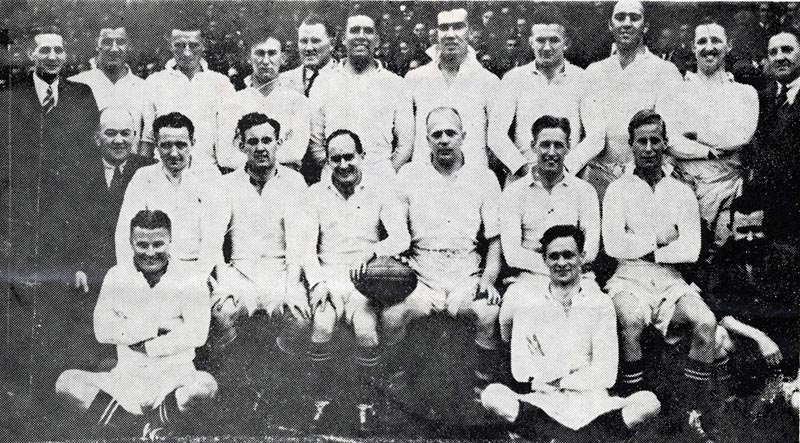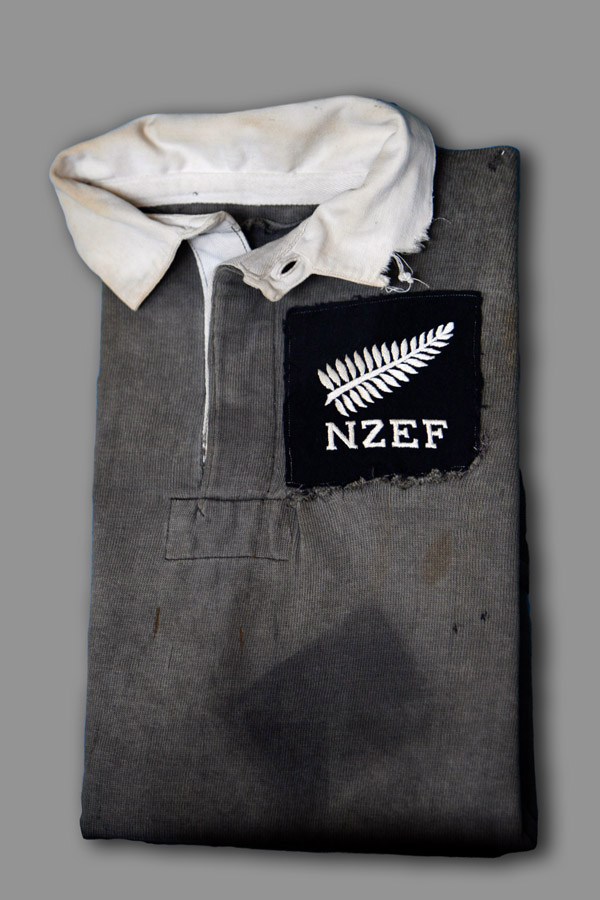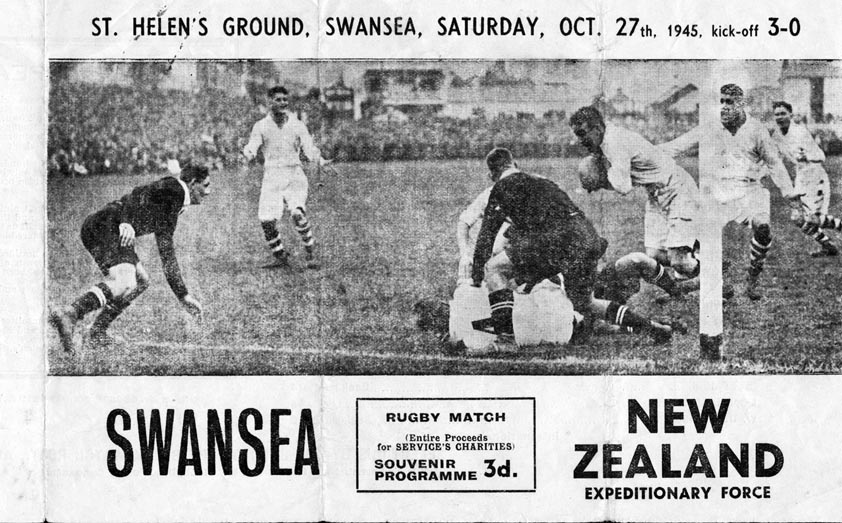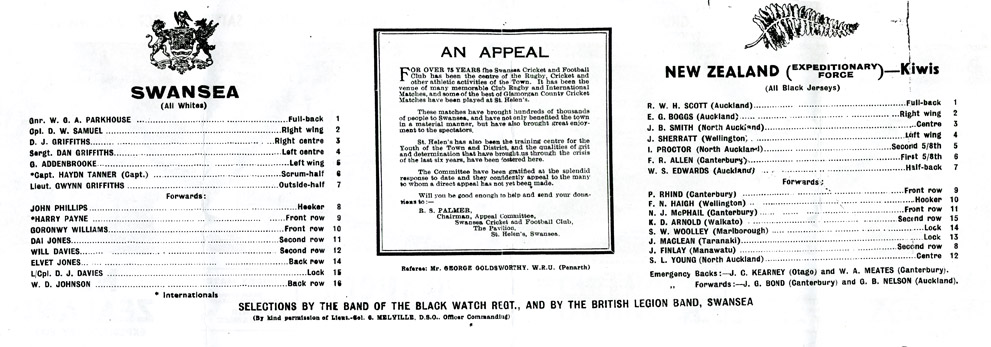| P | W | D | L | Pts, For | Pts. Ag. | T | P | D | C |
| 33 | 18 | 4 | 11 | 358 | 244 | 72 | 20 | 7 | 27 |
MOST APPEARANCES : 30 (GUY ADDENBROKE)
MOST TRIES : 20 (GUY ADDENBROKE)
MOST POINTS : 65 (GUY ADDENBROKE)
NO WALES CAPS DURING SEASON
* In the Exiles XV match (26.01.46), T. Egan changed sides with Guy Addenbroke at half time and scored a try for Swansea in the second half
* Ernest Bevin, Foreign Secretary, kicked off the game versus Aberavon on 16 March 1946

Back row : Trevor Davies(committee), Tom Briggs, John Hopkins, Trevor Petherbridge, Wilf Harris(committee), Rees Williams, Jim Hunt, Tom Rees, Trevor Lewis, Dai Jones, J Elwyn Watkins(committee).
Middle row : Cliff Prosser(secretary), Gwyn Griffiths, Denzil Llewellyn, Major Charles Saxton capt. (NZ), Harry Payne, Len Davies, R E Dobson (NZ), Trevor Jones (referee).
(Club Archive – Courtesy of Howard Evans)

In the Exiles XV game (26th January 1946), T Egan changed sides with Guy Addenbroke at half time and scored a try for Swansea in the 2nd half. Ernest Bevin, Foreign Secretary, kicked off the game at Aberavon on 16th March 1946.
At the conclusion of the 1st post war season the club’s playing record read as follows : played 33, won 18, drawn 4, lost 11, points for 358, points against 244. Wing Guy Addenbroke achieved the seasons most appearances/tries/points with 30/20/65 respectively.
Original Restored by David Dow at Dragon Tales Rugby 2006.
www.dragontalesrugby.com 01792-419756, 07779 043 048.
Swansea RFC fixture list 1945-46 (Club Archive)

This jersey belonged to C. K. (Charlie) Saxton, captain of the New Zealand Expeditionary Force Rugby team known as the ‘Kiwis’. They toured Britain and Europe in 1945-46 at the end of WW II and were acclaimed for the open, adventurous style of football played. They played Swansea at St Helens on 27 October 1945 winning by 22 pts to 6 pts in a game more characteristic of a Barbarians fixture.Presented by C. K. Saxton (Timaru HSOB, S. Canterbury,NZ 1938 & NZEF 1945-46)
(Club Archive)
SWANSEA 6 KIWIS 22 (at St Helen’s, 27th October, 1945)
At the end of World War Two, many New Zealand soldiers, naturally, returned home, but a decision was made by their commanders, in particular Lieut-General Sir B.C.Freyberg, that a rugby tour was to be undertaken in Great Britain and France.
Though, over 50 years afterwards, when I met up with many of the players on a reunion tour to Wales, and suggested that surely they would have wanted to return home as soon as possible after years of fighting, to a man, they said: “Whatever for, when a rugby tour was on!”
Even Prisoners of War took part in trials for the tour and soldiers from Italy alone numbered over 300 applying, while the selectors sat down in Egypt and trials took place in Austria, before 38 possible players came from Italy; 23 from Austria and three POW’s and all were shipped to England.
After further trials, 31 were selected and those over joined a NZ Services side that made a shorter tour of Britain and France. It left the main body to be called The Kiwis (The 2nd NZ European Forces). Almost all of the party were to win full caps on their return and two had already been capped pre-war.
Now, over to the greatest of all rugby commentators, the late Winston McCarthy, who later wrote ‘Broadcasting with the Kiwis’.
Howard Evans.
….If you want to start a rugby tour of the British Isles in the toughest possible way, let me recommend you to Wales and if history is correct, Swansea should give you all the thrills you want.
Swansea were our historic enemies. They had held the 1905 side to 4-3; lost 39-3 to the 1924 Invincibles, but triumphed 11-3 over the 1935 All Blacks. And the man who had played scrum half for Swansea in that victory, Haydn Tanner, came all the way home from Germany to lead the All Whites out. He is still the best scrum half in World rugby, despite his age.
Apart from the injured Cyril Saxton, it was thought to be the best side the Kiwis could put out. Some 20,000 Welshmen sang ‘Land of my Fathers’ and it thrilled everyone – it was magnificent.
Everyone sat down and the fun started and how the Welshmen roared as Tanner, their idol, slipped round the scrum after five minutes. Tanner made straight at rigbt wing Eric Boggs, but then slipped a reverse pass to flanker Elvet Jones and he was over. (3-0). How the crowd roared!
Hundreds of NZ servicemen were there watching and they roared back as Jim Sherratt barged through two tacklers and scored. (3-3). Next, forward ‘KD’ Arnold was over and Bob Scott converted. (3-8). The Swansea forwards now took a hand in affairs and Tanner kept the Kiwi defence occupied, but it was still 3-8 at the interval.
The Kiwis wheeled scrums cleverly and a forward passing move saw skipper Major Jack Finlay (Military Cross) sent Stan Young in for Scott to convert. (3-13) Scott added a penalty from almost halfway. (3-16)
Then, full back Gilbert Parkhouse, later a Glamorgan and England cricketer, but then Gunner W.G.A.Parkhouse(!), kicked a good goal also from near halfway. (6-16) That set the Kiwis playing brilliant rugby, though Parkhouse was a marvellous tackler.
A try had to come and the great Maori Johnny Smith ran through and gave to Sheratt, at least that was it seemed. Instead, Smith dummied and scored himself. (6-19)
Freddie Allen made the final try as dummied and side-stepped for Sherratt to finish it off, but the Swansea defence held off any further score. (6-22)
Teams.
SWANSEA – Gnr W G A Parkhouse; Cpl D W Samuel, D J Griffiths, Sgt Dan Griffiths, Guy Addenbrooke; Lieut Gwynn Griffiths, Capt Haydn Tanner (capt); Goronwy Williams, Harry Payne, John Phillips, Will Davies, Dai Jones, W Dill Johnson, L/Cpl D J Davies, Elvet Jones.
KIWIS – Dvr R W H Scott; Cpl E G Boggs, Pte J B Smith, Pte I Proctor, Lieut J R Sherratt; Lieut F R Allen, Pte W S Edwards; Capt P K Rhind, Pte F N Haigh, Capt N J McPhail, Dvr J MacLean, Cpl S W Woolley, Cpl S L Young, Major J Finlay MC (capt), Pte KD Arnold.
Referee – George Goldsworthy (Penarth).
In 33 games, the Kiwis won 29, drew against Leinster and Newport and lost to Monmouthsire and Scotland. They defeated Wales, England and France (twice).
(This contribution to the 1945-46 Season was kindly compiled and submitted by Howard Evans: Record keeper for the IRB Yearbook)


 1945-46 “Kiwis”
1945-46 “Kiwis”
Back Row (L to R): L/Bdr. R. L. Dobson, Cpl. E. G. Boggs, Capt. N. J. McPhail, Pte. K. D. Arnold, Pte. W. A. Meates, Lt. N. H. Thornton, Pte. J. G. Bond, Gnr. D. S. Bell, Pte. F. N. Haigh, Dvr. R. W. H. Scott.
3rd Row (L to R): Capt. P. J. Guyton, Pte. J. G. Simpson, Lt. J. R. Sherratt, Maj. G. B. Nelson, Sgt. L. A. Grant, Cpl. S. A. Young, Tpr. A. W. Blake, Cpl. S. W. Wooley, Dvr. W. G. Argus, Lt. J. A. Gasson.
2nd Row (L to R): Maj. V. C. Butler, Pte. R. D. Johnstone, Capt. P. K. Rhind, Maj. C. K. Saxton Captain), Col. A. H. Andrews (Manager), Maj. J. Finlay (Vice-Captain), Pte. J. B. Smith, Lt. F. R. Allen, Lt. W. J. McCarthy.
Front Row (L to R): Pte. W. S. Edwards, Pte. I. Proctor, Tpr. H. E. Cook, Tpr. J. C. Kearney, Pte. M. S. Ingpen, Gnr. A. N. King.
Absent: Dvr. J. Maclean. (Club Archive).
The 2nd New Zealand Expeditionary Force Rugby Football Team
Popularly known as the Kiwis, they became one of the most influential and significant teams in rugby history.
Their contribution to rugby lore was twofold: they resuscitated international rugby after World War II and they played a brand of rugby that set new standards of innovation and entertainment, in much the same way as the 1905 Original All Blacks had. But the Kiwis were not All Blacks.
They were soldiers and they were selected after active service in North Africa and Italy and, in some cases, after lengthy spells in prisoner of war camps in Italy, Austria and Germany.
Charlie Saxton, the 1938 New Zealand halfback and the only All Black among them, was chosen as captain. But such was the quality of their play, 15 of the team of 29 later played for the All Blacks.
The Kiwis played 33 matches in Europe for 29 wins, two draws and two losses.
They scored 605 points and conceded just 185. They beat the full international sides of England, Wales and France and lost just one international, to Scotland.
It was no coincidence that another rugby team regarded as one of the greatest sides, the 1967 All Blacks, were managed by Saxton and coached by another Kiwi, Fred Allen.

